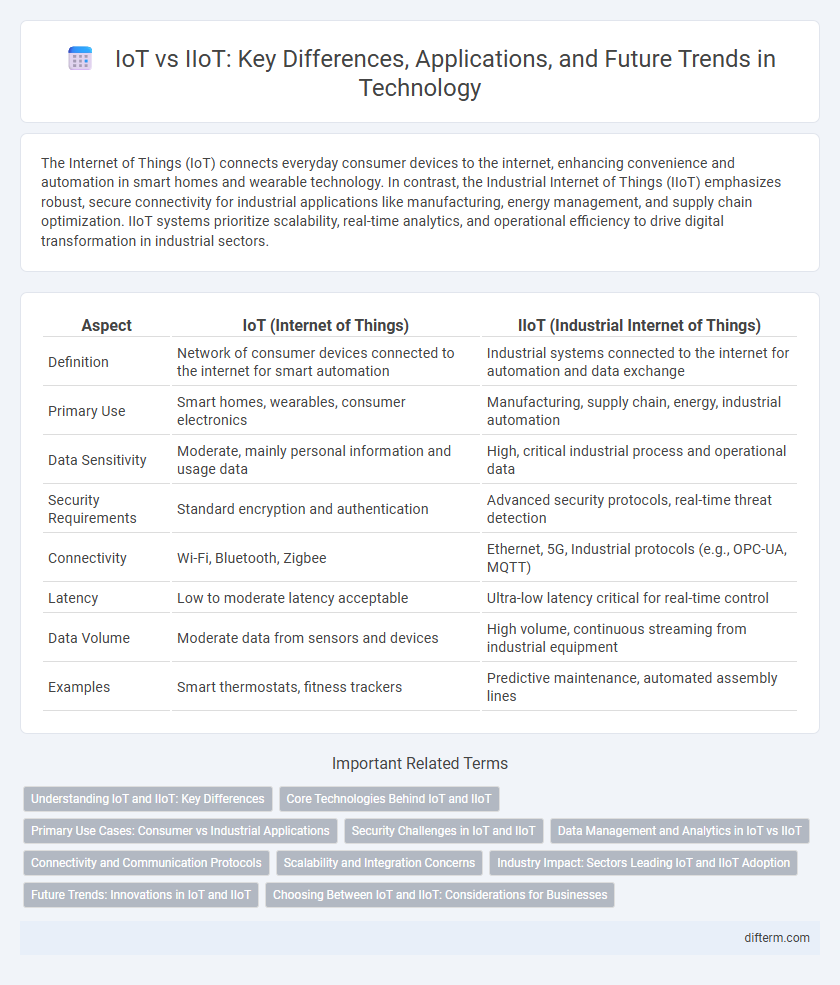The Internet of Things (IoT) connects everyday consumer devices to the internet, enhancing convenience and automation in smart homes and wearable technology. In contrast, the Industrial Internet of Things (IIoT) emphasizes robust, secure connectivity for industrial applications like manufacturing, energy management, and supply chain optimization. IIoT systems prioritize scalability, real-time analytics, and operational efficiency to drive digital transformation in industrial sectors.
Table of Comparison
| Aspect | IoT (Internet of Things) | IIoT (Industrial Internet of Things) |
|---|---|---|
| Definition | Network of consumer devices connected to the internet for smart automation | Industrial systems connected to the internet for automation and data exchange |
| Primary Use | Smart homes, wearables, consumer electronics | Manufacturing, supply chain, energy, industrial automation |
| Data Sensitivity | Moderate, mainly personal information and usage data | High, critical industrial process and operational data |
| Security Requirements | Standard encryption and authentication | Advanced security protocols, real-time threat detection |
| Connectivity | Wi-Fi, Bluetooth, Zigbee | Ethernet, 5G, Industrial protocols (e.g., OPC-UA, MQTT) |
| Latency | Low to moderate latency acceptable | Ultra-low latency critical for real-time control |
| Data Volume | Moderate data from sensors and devices | High volume, continuous streaming from industrial equipment |
| Examples | Smart thermostats, fitness trackers | Predictive maintenance, automated assembly lines |
Understanding IoT and IIoT: Key Differences
The Internet of Things (IoT) connects everyday consumer devices like smartphones and wearables to the internet for improved convenience and automation. In contrast, the Industrial Internet of Things (IIoT) focuses on integrating sensors, machines, and analytics within industrial environments to optimize operational efficiency and predictive maintenance. Key differences lie in scale, security requirements, and application complexity, with IIoT demanding robust data handling and real-time processing for critical infrastructure.
Core Technologies Behind IoT and IIoT
IoT relies on core technologies like wireless sensors, cloud computing, and data analytics to connect consumer devices and enable smart home automation, wearables, and environmental monitoring. IIoT integrates advanced machine learning, industrial-grade sensors, edge computing, and real-time data processing to optimize manufacturing, supply chain management, and predictive maintenance. Both leverage connectivity protocols such as MQTT and 5G but differ in their scale, security requirements, and industrial application specificity.
Primary Use Cases: Consumer vs Industrial Applications
IoT primarily serves consumer applications such as smart homes, wearable devices, and connected vehicles, enhancing convenience and personal lifestyle management. IIoT focuses on industrial environments including manufacturing automation, predictive maintenance, and supply chain optimization, driving efficiency and reducing operational costs. Both leverage sensors and data analytics but cater to distinct sectors with unique performance requirements and security standards.
Security Challenges in IoT and IIoT
IoT security challenges include device heterogeneity, weak authentication, and limited encryption, exposing networks to data breaches and cyberattacks. IIoT security faces amplified risks due to industrial control systems' critical role, where vulnerabilities can lead to operational disruptions and safety hazards. Implementing robust identity management, network segmentation, and real-time monitoring is essential to mitigate threats in both IoT and IIoT environments.
Data Management and Analytics in IoT vs IIoT
IoT data management primarily handles consumer-generated data characterized by high volume and velocity but lower criticality, requiring scalable cloud storage and basic analytics for user behavior insights. IIoT data management focuses on highly sensitive, real-time industrial data from sensors and machinery, demanding edge computing integration, stringent security protocols, and advanced predictive analytics for operational efficiency and preventive maintenance. The analytical complexity in IIoT surpasses IoT due to the need for real-time decision-making and integration with enterprise resource planning (ERP) systems and industrial automation.
Connectivity and Communication Protocols
IoT devices primarily use Wi-Fi, Bluetooth, and Zigbee protocols to enable connectivity and data exchange in consumer environments, while IIoT leverages industrial-grade communication standards like OPC UA, Modbus, and MQTT for robust, real-time data transmission in manufacturing and automation systems. IIoT emphasizes low latency, high reliability, and secure protocols to ensure seamless machine-to-machine communication in critical infrastructure. Edge computing integration further enhances IIoT connectivity by processing data closer to the source, reducing bandwidth usage and improving response times.
Scalability and Integration Concerns
IoT platforms often emphasize user-friendly scalability tailored for consumer devices, while IIoT solutions demand robust, industrial-grade scalability to support extensive sensor networks and real-time data processing. Integration in IoT usually involves connecting diverse consumer gadgets through standardized protocols, whereas IIoT requires seamless interoperability with legacy industrial systems, SCADA, and enterprise resource planning (ERP) software. Ensuring secure, scalable integration in IIoT environments often involves complex middleware and edge computing architectures to handle high data velocity and critical operational reliability.
Industry Impact: Sectors Leading IoT and IIoT Adoption
Manufacturing, energy, and transportation sectors lead IIoT adoption by integrating advanced sensors, predictive maintenance, and real-time data analytics to optimize industrial processes and reduce downtime. In contrast, consumer IoT thrives in smart homes, wearable devices, and healthcare, enhancing convenience, personalization, and remote monitoring. The industrial sector's emphasis on scalability, security, and interoperability drives IIoT innovation, distinguishing its application and impact from broader consumer IoT ecosystems.
Future Trends: Innovations in IoT and IIoT
Future trends in IoT and IIoT emphasize the integration of 5G technology to enhance connectivity and reduce latency across industrial and consumer applications. Edge computing innovations enable real-time data processing, significantly improving efficiency and decision-making in sectors such as manufacturing, healthcare, and smart cities. Advanced AI algorithms combined with IoT and IIoT systems drive predictive maintenance and autonomous operations, shaping the next generation of intelligent, interconnected environments.
Choosing Between IoT and IIoT: Considerations for Businesses
Choosing between IoT and IIoT depends on the specific business goals and operational environments, with IoT primarily enhancing consumer convenience and IIoT driving industrial efficiency and automation. IIoT incorporates advanced analytics, machine learning, and robust security protocols tailored for manufacturing, energy, and supply chain sectors. Businesses should evaluate scalability, data integration needs, and real-time monitoring capabilities to determine the optimal solution for optimizing performance and reducing operational costs.
IoT vs IIoT Infographic

 difterm.com
difterm.com